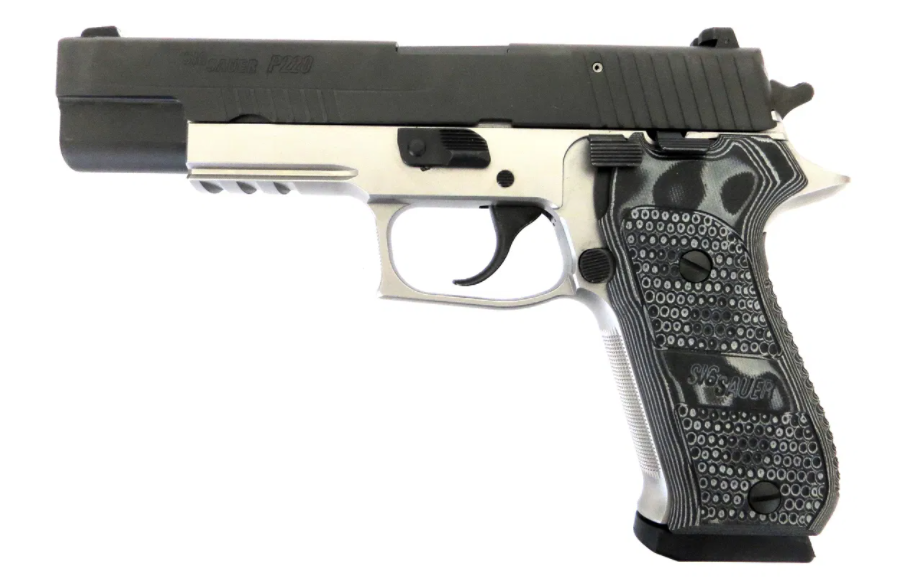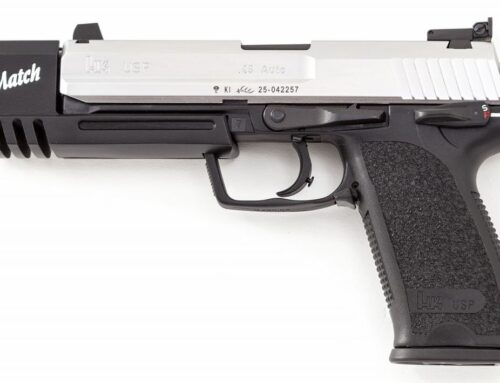Sometimes it doesn’t take much to gather my everlasting adoration. A few years back while out of state I was picking through some gun magazines and came across an article on a very pretty looking Sig Sauer handgun. It was a beast of a machine with a matte stainless frame, black slide, five inch barrel, G10 grips and black controls. I would have looked right past it as being another special run of their single stack .45 caliber metal P-series handgun until I caught what it was chambered in: Ten millimeter auto.
What started as a piece of eye candy immediately became something of an obsession. It hadn’t been all that long ago that I was prowling for a good ten mil, of which options were very few and far between. This was a few years before the caliber really started to come back into popularity when all I was fortunate enough to find was a second hand EAA Witness in the centimeter cartridge. All it took was one magazine ad for me to be willing to give up a fifteen round capacity for one that only held eight.
After flying back home about a week later I wasted no time in checking the closest three stores in my area. Only one had the model from the article in stock, and only one of them was in the entire store. The guy I spoke to behind the counter didn’t know they had it, either. No matter, I took care of that in a hurry.
This obsession ticked all of the right boxes. A metal framed Sig pistol with the extended beavertail. Ten mil. Fixed SigLite three dot night sights. I know, I’m peculiar in wanting the non-adjustable target sights on a big ol’ ten but whatever. It also had their SA/DA action with decocker while other models have a single action only trigger with ambi safety. For me it was like a P226 on steroids. The sights are the same, the controls are the same, but it’s sending way more energy downrange. It was a direct step up from what had already been my favorite pistol.
The 220-10 is built like a tank. Sig lists the empty weight at a hefty 44 ounces. The recoil spring is Sig’s typical braided design but painted purple on one end. It’s also the only captive recoil assembly that I’ve seen on a metal framed Sig pistol. Being a single stack the grip is slimmer overall, making for a gun which is heavy and somewhat awkward yet still feels good in the hand and points naturally. I can’t help but see it as a “Desert Eagle Lite.” It’s a little shorter, a little thinner (okay, a lot thinner,) a little lighter, and still packs eight powerful rounds in a single stack. It’s a usable sort of fire-breathing ludicrousness. Every time I have it out on the range there’s inevitably at least one person who will be all grins asking “Is that a ten?”
Why yes. Yes it is.
The 220-10 has come out in a number of variations, many of which seem to have had a short production life. At launch there were a couple of versions including this stainless model, the Lipsey’s “reverse two-tone” Match Elite with fixed sights and decocker. Its two sister models were a Kryptek camo Hunter model and an all stainless model with rosewood grips, both with a single action only trigger, fiber optic front sight and adjustable rear sight. Somewhere along the way an all black single action model hit the scene. These days the two tone model appears to have been replaced in Lipsey’s catalogue with the Emperor Scorpion version in flat dark earth PVD. The 220-10 has also been given the Legion treatment available both with the decocker or a single action trigger, both variants coming with a third magazine.
Being one of the metal P-series there’s a fair bit that can be done to the 220-10. The controls all appear to be shared with the standard 220 with one exception. The 220 has had quite a long run, first coming out as a single stack 9mm. I learned the hard way that the 220 style trigger with the grooved front is designed for an earlier generation and is too narrow for current frames. Wanting one of the thicker triggers for mine I wound up buying one meant for a P226 and it dropped right in.
One curiosity which I have yet to properly investigate is whether a .45 caliber upper and magazine can be dropped onto a 220-10 frame or if there are any internal differences which would prevent such a conversion. I can’t remember the last time I’ve seen or held a .45 cal 220 which is a bit of a shame as I’ve always appreciated them. The one .45 I had a chance to try years back left a good impression as I had shot quite well with it.
How’s the bigger badder 220-10 shoot? Like a metal framed Sig in a proper caliber. It has bark, it has bite, it’s appropriately aggressive and takes a firm hold, but it isn’t TOO wild. Thanks to the longer barrel, seven inch sight radius and very capable cartridge you can expect wonderful accuracy out of these guns.
I ended up swapping the rough G10 groups for some Hogue overmold rubber ones with finger grooves. As much as it pained me to cover up the beautiful cross checkering on the front of the frame I find these grips really help to cushion some of the bite and tame some of the muzzle flip. In addition, they look quite nice on the stainless frame. The G10’s were good but they weren’t black, they were a mixed smattering of greys and had a peculiar brownish green tint which didn’t look right to me.
The Elite marking on the slide gets you more than that extra beavertail on the back. The 220-10 also has front slide serrations and Sig’s short reset trigger which I am a big fan of. Double action is on the heavy side, it frequently stages and isn’t the smoothest, but even with the decocker model the single action pull is solid. Initial take-up has a fair bit of travel but with very little resistance before hitting the second stage. Here there is a small bit more travel, it won’t break immediately but once it does there is zero overtravel. Reset is short and quick, returning directly to the second stage. Follow-ups can be made quick, exactly like my 226.
Any complaints that I have with the 220-10 are entirely minor. Magazines tend to be difficult to insert as they like to catch on the release button’s shelf if not firmly inserted. The trick is to reload like you mean it. If it hangs up just give it a smack and you’re back in business. Issue two are that the 10mm specific magazines aren’t the easiest to find, though I can understand as these guns in particular are not the most prolific. This leads to my third issue and it’s more of a concern than a complaint. How difficult will it be to get a new recoil spring for these guns? I honestly do not know.
My bottom line, this is one of those firearms which will forever be treasured and never be traded or sold. Since the 220-10 hit the market Sig also started producing 10mm ammo and I feel that played into the cartridge making a successful return. The timing seemed ideal as both landed right at the point where .40 caliber was falling out of favor, allowing the ten auto to rightfully reclaim its crown. As all of these pieces came together we are now left with the most powerful Sig pistols to date.








